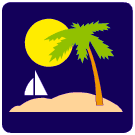

Goals:
1. This introductory lesson will help the students become acquainted with this two week
journey and discovery of Hawaii.
2. This lesson will help the students recall their background knowledge that they have
already obtained on Hawaii.
3. This lesson will help students realize that teamwork is an essential component to this
two-week project.
Resources / Materials:
1. Books and guides that will provide an introductory vocabulary on Hawaii.
Editors of Sunset Books & Sunset Magazine. (1993). Hawaii: A Guide to All the Islands. Menlo Park, California: Sunset Publishing Company.
(ISBN 0-376-06310-6)
Fradin, Brindell. (1994). From Sea to Shining Sea: Hawaii. Chicago, Illinois: Childrens Press. (ISBN 0-516-03811-7)
McNair, Slyvia. (1990). America the Beautiful: Hawaii. Chicago, Illinois: Childrens Press. (ISBN 0-516-00457-3)
Thompson, Kathleen. (1996). Potrait of America: Hawaii. Austin, Texas: Raintree Steck-Vaughn Publishers. (ISBN 0-8114-7331-7)
2. Color pictures, slides or films to help introduce the topic.
Virtually Hawaii (http://satftp.soest.hawaii.edu/space/hawaii/)
Hawaii Visitors & Convention Bureau Video (http://www.gohawaii.com/hokeo/talk/video.html)
The Islands of Aloha (http://www.gohawaii.com/tal k/ioa.html)
Hawaii: The Islands of Aloha (http://www.visit.hawaii.org/)
Time:
This opening project will take 1 to 1.5 hours, depending on the length and depth of the opening tour, and the amount of prior knowledge that the students bring to the opening activity.
Procedure:
1. Greet students at the door and give them name tags they will use for the next two
weeks. The teacher will take their common names and translate them into Hawaiian
names using the Hawaiian language and alphabet. An additional option is for each
student to receive a lei to wear for the day.
2. The classroom will be changed to indicate the new unit. Each of the four classrooms
will be designated an island, which will have no relevance in this lesson but will for
the rest of the unit. There will be decorations and Hawaiian music playing.
3. Once in the room, the teachers will give a presentation and/or a brief tour of the
Hawaiian Islands. The presentation will include either pictures, slides, or film to give
students visual images of Hawaii's waters. This activity will also allow the teachers to
outline the parameters for the next two weeks and explain the intent of the project:
Oceans affect students every day and are important in a worldly view.
4. After the introduction, the 25 students in each classroom will be divided into four
groups of 6 or 7 people, formed by the teacher to ensure a balance of high- and low-
achieving students. Each group will be given a word find containing 30 words
associated with the waters of Hawaii. The words will not be given on the sheet, and
the students will not know how many there are in the puzzle. 15 minutes will be
allotted for the groups to come up with as many words as it can find.
5. Once the 15 minutes has expired, the teacher will ask each group in rotating
succession for a word - a different member of the group must cite a new word each
time the rotation gets back to the same group. In addition to identifying the word, the
group will have to explain how it relates to Hawaii and this assignment.
6. The teacher continues to ask each group until the list of words is completed. The
group that gives the last word "wins" and gets to choose which of the four islands they
would like to start the unit with. (They "win" but in reality it makes no difference
where the students start - since all the islands will be covered within the two weeks.
This will be explained to the other groups, who will also choose a starting point .)
7. The teacher will complete the puzzle (answer sheet) and identify all words that were not found by the
students. The teacher will also ask the students if there are any other words they think
should have or could have been in the puzzle.
8. Once this activity is completed, the students will break up into their groups and begin
their journeys on the island they chose. (Each group will spend two days on each of
the four islands.)
Assessment:
1. Each group must turn in a collective paper of the words they found (Criteria for
Success = Students must locate 20 - 22 words within this word find.)
2. Each group must present a new word during the rotation exercise part of the lesson.
(Criteria for Success = Each group will need to introduce 4 - 5 words from the word
find.)
Curricular Strands and Concepts:
1. Language Arts - Finding words includes knowledge of the terms plus spelling.
Changing of names helps students acquire a taste for other languages and alphabets.
2. Science - Word knowledge consists of several scientific aspects of islands and water.
3. Social Studies - Geographic position of Hawaii and knowledge of lifestyles and
culture traits are also necessary to find words.
Go to Schedule of Lessons